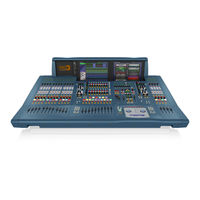Midas PRO3 Manuals
Manuals and User Guides for Midas PRO3. We have 1 Midas PRO3 manual available for free PDF download: Owner's Manual
Midas PRO3 Owner's Manual (668 pages)
PRO SERIES LIVE AUDIO SYSTEMS
Brand: Midas
|
Category: Music Mixer
|
Size: 30.78 MB
Table of Contents
-
Licences
13 -
Precautions
17 -
Contents
36 -
Overview
43 -
-
Overview50
-
Key Features51
-
Applications55
-
FOH and MON59
-
System Buses59
-
MIX Matrix60
-
Processing62
-
Network65
-
Gui66
-
-
-
Text Editing99
-
-
Introduction113
-
-
Standard Tooltip130
-
List Tooltip130
-
-
How to Patch136
-
-
-
Setting up a MIX148
-
MIX Bus Routing150
-
Linking150
-
-
Using Fader Flip150
-
Surround Panning162
-
-
Using solo A/B179
-
Solo Hierarchy181
-
-
-
-
Delay (GUI Only)187
-
-
Solo System187
-
Signal Generator192
-
Talk Osc/Routing194
-
Talk MIC196
-
-
-
Effect Programs208
-
Delay Effect208
-
Flanger Effect212
-
Phaser Effect213
-
-
Feedback216
-
-
-
About the I Zone229
-
-
-
About Automation239
-
-
Next LCD Button241
-
-
Scenes243
-
Scene Contents244
-
Point Scenes244
-
Global Scene244
-
Date and Time245
-
Scene Cue List245
-
Using Zoom250
-
Show Files251
-
Rehearsals252
-
Safes253
-
-
-
Global Scene263
-
About Events263
-
-
-
-
GEQ Compensation296
-
Zones299
-
-
FOH MIX Setup301
-
Monitor MIX303
-
-
-
Input Metering324
-
-
Using Gain Swap330
-
Processing Order330
-
Direct Output330
-
-
-
Compressor332
-
Compressor Graph334
-
Gate336
-
Side Chain338
-
-
Insert340
-
EQ (E Zone)341
-
EQ Graph343
-
-
Mixes345
-
-
Fader351
-
Outputs353
-
-
Output Metering360
-
Talk361
-
Dynamics and EQ361
-
EQ (E Zone)363
-
EQ Graph367
-
-
Safes371
-
Processing Order371
-
Mixes371
-
Masters372
-
Appendices
381 -
-
-
Description383
-
-
-
-
DL251 I/O Box398
-
DL351 I/O Box398
-
DL451 I/O Box399
-
DL371 Dsp/Router401
-
-
-
Meters410
-
Screens410
-
Screen Functions410
-
LCD Switches410
-
-
-
Notes411
-
Using the GEQ411
-
Live Use (MON)411
-
Bypassing the EQ412
-
-
-
-
Audio419
-
Digital419
-
Parameters419
-
Controls419
-
-
-
No Audio435
-
Diagnostics435
-
Reset Switches440
-
-
-
Introduction463
-
Overview464
-
Inputs465
-
Patching465
-
Configuration466
-
Dynamics468
-
Insert469
-
Aux Send471
-
Matrix Send472
-
Fader473
-
-
-
Patching475
-
Configuration476
-
Dynamics477
-
Insert477
-
Aux Send477
-
Matrix Send478
-
Fader479
-
-
-
Patching481
-
Configuration482
-
Dynamics483
-
Insert484
-
Aux Send485
-
Aux Preset485
-
Matrix Send486
-
Fader487
-
-
Matrices489
-
Patching489
-
Configuration490
-
Dynamics491
-
Insert492
-
Aux Send493
-
Aux Preset493
-
Matrix Send493
-
Fader494
-
-
Masters495
-
Patching495
-
Configuration496
-
Dynamics497
-
Insert498
-
Aux Send499
-
Aux Preset499
-
Matrix Send500
-
Fader501
-
-
GEQ Rack502
-
Effects Rack504
-
Groups506
-
-
-
Overview511
-
Inputs512
-
EQ Safe514
-
MIC Safe517
-
MUTE Safe518
-
FADER Safe519
-
-
EQ Safe522
-
MIC Safe525
-
MUTE Safe526
-
FADER Safe527
-
-
EQ Safe529
-
MIC Safe530
-
MUTE Safe531
-
FADER Safe532
-
Matrices533
-
EQ Safe535
-
MIC Safe538
-
MUTE Safe539
-
FADER Safe540
-
Masters541
-
EQ Safe543
-
MIC Safe546
-
MUTE Safe547
-
FADER Safe548
-
Groups549
-
EQ Safe549
-
Dynamic Safe549
-
MIC Safe549
-
Automation Safe550
-
Mute (MTE) Safe551
-
Fader (FDR) Safe552
-
-
-
-
Overview553
-
Inputs554
-
Configuration554
-
Compressor556
-
Gate558
-
Bus Sends560
-
Master Routing561
-
-
Aux562
-
Configuration562
-
Compressor563
-
Gate564
-
Eq (Geq)564
-
Bus Sends566
-
Master Routing567
-
-
Return568
-
Compressor568
-
Configuration568
-
Bus Sends569
-
Gate569
-
Master Routing570
-
Configuration571
-
Matrix571
-
Compressor572
-
Eq (Geq)573
-
Gate573
-
Bus Sends574
-
Fader Section575
-
-
-
Master576
-
Configuration576
-
Compressor577
-
Gate578
-
Eq (Geq)578
-
Bus Sends579
-
Master Routing580
-
-
-
-
Overview581
-
Input Controls582
-
Inputs582
-
Direct Input583
-
Direct Output583
-
Filters584
-
Dynamics585
-
Insert587
-
Bus Sends589
-
Master Routing590
-
Fader591
-
Delay592
-
Input Controls593
-
Direct Input594
-
Direct Output594
-
Filters594
-
Dynamics595
-
Insert596
-
Bus Sends598
-
Master Routing599
-
Fader600
-
Delay601
-
-
Direct Output602
-
Input Controls602
-
Return602
-
Direct Input603
-
Dynamics603
-
Filters603
-
Insert603
-
Bus Sends604
-
Master Routing605
-
Delay606
-
Fader606
-
Direct Output607
-
Input Controls607
-
Matrix607
-
Direct Input608
-
Filters608
-
Bus Sends612
-
Master Routing612
-
Fader613
-
Delay614
-
Input Controls615
-
Master615
-
Direct Input616
-
Direct Output616
-
Filters616
-
-
-
Config Sections624
-
Comp./Output Dyn626
-
Gates627
-
Aux Sends629
-
Matrix Sends630
-
Fader Sections631
-
-
Recall Scope631
-
Store Scope631
-
Routing632
-
-
Config Sections633
-
Comp./Output Dyn634
-
Gates634
-
Aux Sends634
-
Matrix Sends634
-
Fader Sections635
-
-
Recall Scope636
-
Store Scope636
-
Routing636
-
Config Sections637
-
Comp./Output Dyn638
-
Gates639
-
Fader Sections641
-
Store Scope642
-
Recall Scope642
-
Routing642
-
Config Sections643
-
Comp./Output Dyn644
-
Gates645
-
Aux Sends646
-
Matrix Sends646
-
Fader Sections647
-
Recall Scope648
-
Store Scope648
-
Routing648
-
-
Effects649
-
Geqs649
-
VCA/POP (Groups)649
-
Config Sections650
-
Comp./Output Dyn651
-
Gates652
-
Aux Sends653
-
Matrix Sends653
-
Fader Sections654
-
-
Recall Scope655
-
Routing655
-
Store Scope655
-
-
-
Glossary
659
Advertisement
